Abstract
In the central part of Hungary, an earthquake with the local magnitude of 4.5 occurred near the town of Oroszlány, on 29 January 2011. The main shock and its more than 200 aftershocks were recorded by a significant number of three-component seismic stations, which enabled us to perform multiple event location on the event cluster. We applied the double difference, HypoDD method to relocate the aftershock sequence in order to identify the pattern of active faulting. We used the extended International Seismological Centre location algorithm, iLoc to determine the initial single event locations for the aftershock sequence and applied multiple event location algorithm on the new hypocenters. To improve both location precision and accuracy, we added differential times from waveform cross correlation to the double-difference multiple event location process to increase the accuracy of arrival time readings. We show that both HypoDD collapses the initial, rather diffuse locations into a smaller cluster and the vertical cross-sections show sharp images of seismicity. Some of the relocated events in the cluster are ground truth quality with a location accuracy of 5 km or better. Having achieved accurate locations, we further examined the extent of the seismogenic zone. We investigated the relationship between geothermics and seismicity through strength profiles constructed for the study area. The aftershocks of the Oroszlány earthquake are dominantly in the range of 5–10 km, fitting well to the extent of the thin brittle part of the crust. It shows that the events are well in accordance with a thermally attenuated lithosphere and elevated geothermal gradient in the upper crust and basin sediments. These findings underline the geothermal prospectivity of the Panonian Basin.






Similar content being viewed by others
References
Bada G, Horváth F, Dövényi P, Szafián P, Windhoffer G, Cloetingh S (2007) Present-day stress field and tectonic inversion in the Pannonian basin. Global Planet Change 58:165–180
Bodri B (1996) Thermal state, rheology and seismicity in the Pannonian basin, Hungary. J Geodyn 21:309–328
Bondár I, McLaughlin K (2009) Seismic location bias and uncertainty in the presence of correlated and non-Gaussian travel-time errors. Bull Seismol Soc Am 99:172–193
Bondár I, Storchak D (2011) Improved location procedures at the International Seismological Centre. Geophys J Int 186:1220–1244
Bondár I, Myers SC, Engdahl ER, Bergman EA (2004) Epicentre accuracy based on seismic network criteria. Geophys J Int 156:483–496
Budai T, Fodor L (2008) Geology of the Vértes Hills Explanatory book to the geological map of the Vértes Hills (1:50 000) Regional map series of Hungary Geological Institute of Hungary, Budapest
Carter NL, Tsenn MC (1987) Flow properties of continental lithosphere. Tectonophysics 136:27–63
Cloetingh S et al (2010) Lithosphere tectonics and thermo-mechanical properties: an integrated modelling approach for enhanced geothermal systems exploration in Europe. Earth Sci Rev 102:159–206
Dobosi G, Kempton PD, Downes H, Embey-Isztin A, Thirlwall M, Greenwood P (2003) Lower crustal granulite xenoliths from the Pannonian Basin, Hungary, Part 2: Sr–Nd–Pb–Hf and O isotope evidence for formation of continental lower crust by tectonic emplacement of oceanic crust. Contrib Miner Petrol 144:671–683
Fernandez M, Ranalli G (1997) The role of rheology in extensional basin formation modelling. Tectonophysics 282:129–145
Fodor L et al (2005) An outline of neotectonic structures and morphotectonics of the western and central Pannonian Basin. Tectonophysics 410:15–41
Goetze C, Evans B (1979) Stress and temperature in the bending lithosphere as constrained by experimental rock mechanics. Geophys J Int 59:463–478
Gráczer Z, Wéber Z (2012) One-dimensional P-wave velocity model for the territory of Hungary from local earthquake data. Acta Geod Geophys Hung 47:344–357
Grenerczy G, Kenyeres A, Fejes I (2000) Present crustal movement and strain distribution in Central Europe inferred from GPS measurements. J Geophys Res Solid Earth 105:21835–21846
Kövesligethy Radó Seismological Observatory (Geodetic and Geophysical Institute, Research Centre for Astronomy and Earth Sciences, Hungarian Academy of Sciences; MTA CSFK GGI) (1995) Hungarian National Seismological Network Deutsches GeoForschungsZentrum GFZ. doi:10.14470/UH028726
Lankreijer A, Bielik M, Cloetingh S, Majcin D (1999) Rheology predictions across the western Carpathians, Bohemian massif, and the Pannonian basin: implications for tectonic scenarios. Tectonics 18:1139–1153
Lenkey L, Dövényi P, Horváth F, Cloetingh S (2002) Geothermics of the Pannonian basin and its bearing on the neotectonics. EGU Stephan Mueller Spec Publ Ser 3:29–40
Ranalli G (1995) Rheology of the earth. Springer Science & Business Media, New York
Sachsenhofer RF, Lankreijer A, Cloetingh S, Ebner F (1997) Subsidence analysis and quantitative basin modelling in the Styrian Basin (Pannonian Basin System, Austria). Tectonophysics 272:175–196
Sambridge MS, Kennett BL (2001) Seismic event location: nonlinear inversion using a neighbourhood algorithm. In: Monitoring the comprehensive nuclear-test-ban treaty. Springer, Berlin, pp 241–257
Török K, Németh B, Koller F et al (2014) Evolution of the middle crust beneath the western Pannonian Basin: a xenolith study. Miner Petrol 108:33. doi:10.1007/s00710-013-0287-1
Tóth L, Mónus P, Zsíros T, Kiszely M (2002) Seismicity in the Pannonian Region - earthquake data. Stephan Mueller Spec Publ Ser 3:9–28
Tóth L, Mónus P, Bus Z, Györi E (2008) Seismicity of the Pannonian basin. In: Earthquake monitoring and seismic hazard mitigation in Balkan Countries. Springer, Berlin, pp 99–110
Waldhauser F, Ellsworth WL (2000) A double-difference earthquake location algorithm: method and application to the northern Hayward fault, California. Bull Seismol Soc Am 90:1353–1368
Waldhauser F, Ellsworth W, Schaff DP, Cole A (2004) Streaks, multiplets, and holes: High‐resolution spatio‐temporal behavior of Parkfield seismicity. Geophys Res Lett 31
Wéber Z, Süle B (2014) Source properties of the 29 January 2011 ML 4.5 Oroszlány (Hungary) mainshock and its aftershocks. Bull Seismol Soc Am 104:113–127
Wilks KR, Carter NL (1990) Rheology of some continental lower crustal rocks. Tectonophysics 182:57–77
Zsíros T (2000) Seismicity and Seismic Hazard in the Carpathian Basin Hungarian Earthquake Catalog (456–1995) (in Hungarian). MTA FKK GGKI, Budapest
Acknowledgements
This study was supported by the Kövesligethy Radó Seismological Observatory, providing all efforts and data for our research project. We are grateful to the Georisk Ltd. for the waveforms recorded by the Paks Microseismic Monitoring Network.
Author information
Authors and Affiliations
Corresponding author
Rights and permissions
About this article
Cite this article
Békési, E., Süle, B., Lenkey, L. et al. Double-difference relocation of the 29 January 2011 ML 4.5 Oroszlány earthquake and its aftershocks and its relevance to the rheology of the lithosphere and geothermal prospectivity. Acta Geod Geophys 52, 229–242 (2017). https://doi.org/10.1007/s40328-017-0195-7
Received:
Accepted:
Published:
Issue Date:
DOI: https://doi.org/10.1007/s40328-017-0195-7




